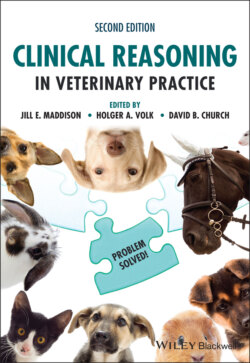Читать книгу Clinical Reasoning in Veterinary Practice - Группа авторов - Страница 24
Problem‐based inductive clinical reasoning
ОглавлениеIn problem‐based inductive clinical reasoning, each significant clinicopathological problem is assessed in a structured way before being related to the other problems that the patient may present with. Using this approach, the pathophysiological basis and key questions (see the following sections) for the most specific clinical signs the patient is exhibiting are considered before a pattern is sought. This ensures that one’s mind remains more open to other diagnostic possibilities than what might appear to be initially the most obvious and thus helps prevent pattern‐based tunnel vision.
If there are multiple clinical signs – for example, vomiting, polydipsia and a pulse deficit – each problem is considered separately and then in relation to the other problems to determine if there is a disorder (or disorders) that could explain all of the clinical signs present. In this way, the clinician should be able to easily assess the potential differentials for each problem and then relate them rather than trying to remember every disease process that could cause that pattern of particular signs. It is important that the signalment of the patient is seen as a risk factor, but this should not blind the clinician to potential diagnoses beyond what is common for that age, breed and sex.
Thus, we do look for patterns but not until we have put in place an intellectual framework that helps prevent tunnel vision too early in the diagnostic process.
Figure 2.2 shows the steps in the clinical reasoning flow. As each step is explained you will see the numbered keys to help you understand where you are in the diagnostic process. We use these steps, their colours and numbered keys throughout the book to help ‘anchor’ the process for you through the repetition shown in Figure 2.1. Colour bars or shading are also used to identify introductory concepts (blue), diagnostic approach and steps (brown) and key introductory and summary points (purple).
Figure 2.2 Clinical reasoning step‐by‐step.
